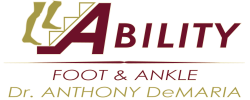Dr. Anthony DeMaria - Greater Cincinnati and Northern, KY Podiatrist
Plantar Fasciitis is an extremely common problem that involves inflammation of the heel, often manifesting as heel pain that gradually worsens over a period of days to weeks; however, a sudden onset of pain has been known to occur. This condition concerns the plantar fascia of the foot, which a very thick, robust type of ligament that is attached to the heel and extends to the forefoot. Its purpose is to help support the arch of the foot while you’re standing. Unfortunately, inflammation can occur to this structure, and can be very debilitating. This condition is often seen in individuals who work on hard surfaces for prolonged periods of time, especially those who must work standing or walking for most of their workday. The pain is often described as sharp, or stabbing in nature, and often presents either first thing in the morning after getting out of bed, or towards the end of the workday after the patient has been on their feet all day.

Typically, the patient will try to get relief by taking over-the-counter anti-inflammatories, attempting some form of over-the-counter heel cushion, different shoes, arch supports, and stretching exercises. There is no shortage of options with this condition, so please keep this in mind when considering care.
If the above fail to improve the symptoms, generally medical attention is needed. MANY variables are involved in this condition, and therefore, what helps one patient may not help another. I can’t tell you how many times a patient has come to me and said, “my friend had this done to their heel to take care of their heel pain, so I tried it too, but it didn’t work for me”.
Conservative treatment options are plentiful and can vary, from physical therapy to orthotics (prescription arch supports), cortisone injections, prescription anti-inflammatories, shoe gear modifications, night splint therapy, and tape strappings to the foot. Surgery is an option, but this is often chosen as a “last resort” if conservative care treatments have been first attempted and failed. The good news is statistically, the odds of avoiding a surgery are in your favor, as often only 1-2 in 10 patients will need surgery. Also, there have been some non-surgical options for difficult cases have shown tremendous promise, such as shock wave therapy and platelet derived growth factor injections; however, these options are seldom covered by insurance companies and are often expensive and are paid for out-of-pocket.
PLEASE also note, that orthotics (shoe inserts / arch supports) can help, BUT again, due to the many variables involved in this problem, NOT ALL SHOES INSERTS WILL WORK AS NOT ALL INSERTS ARE THE SAME. Again, I see so many patients that spend hundreds (if not thousands) of dollars on these devices in vain and still struggle with heel pain. So, BEFORE you are tempted to spend a lot of your hard-earned money on shoe inserts, please give us a call at (859) 746-3668 to schedule an appointment to see what treatment plan is best for you.
